Back to page 1
The Essentials
Impressive architecture and grand design themes abound at Parkview Field. But what is it like to attend a game here?
First, if you can’t find a place to park, you’re obviously at the wrong ballpark. Not only are there surface lots just south of the park, there is the huge parking garage I’ve mentioned a number of times already. Parking for TinCaps games costs $4.
Programs are free, but keep in mind that if you intend to keep score, you get what you pay for in free programs. There is a scorecard section, but there’s no way you could write small enough to fit your scoring in the miniscule boxes. If you’re as hardcore as I am, then bring your own score book.
The cost of admission is a tad high for the Midwest League, but of course a number of MWL parks are a significant step down from Parkview Field. Well, maybe all of them are. Regardless of the ticket prices, you can’t argue with the seating options. The All Star seats in the infield are $9, while the reserved seats farther down each line cost $8. If you simply want to wander around or sit on the outfield berm (it’s nicely terraced in right-center field), a general admission ticket is $5. As an aside, the cost to rent suites on the upper level is as low as at just about any pro park.
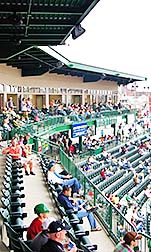 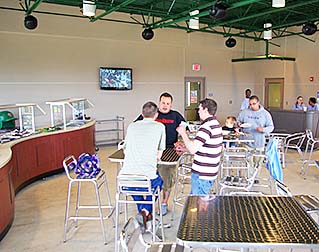 |
Unfortunately, some of the more interesting vantage points often aren’t sold on an individual-ticket basis. The Club Section in the upper deck behind home plate, with its ridiculously ample leg room (above left), sold out in advance for the entire season. Similarly, groups with at least 60 have dibs on the J. Chapman’s party deck down the first-base line in the upper deck (the area is named for John Chapman, which, remember, is Johnny Appleseed’s real name. The area is shown above right). Also, the Appleseed Picnic Pavilion in the right-field corner and the Field Boxes in the left-field corner are for groups, as is the most noteworthy section in the stadium.
That noteworthy section would be the TreeTops area, which rests on top of the meeting rooms that are on the first floor of the parking garage’s ballpark side. Freier says that this “is obviously inspired by the Wrigley (Field) rooftop concept.” He adds that this lofty locale, which comes with an all-you-can-eat menu, is “probably my personal favorite area” in the park. Unlike the similar area in Columbus’ Huntington Park (or, for that matter, across Waveland and Sheffield Avenues from Wrigley), these seats are not bleachers. No, here you’ll find both hightop chairs behind drink rails and also regular tables and chairs. If you can get together a group of 50 or more, the cost is $29 for adults (which includes the food) and $24 for kids. Note that for Tuesday games, individuals can buy tickets here.
Overall, the food offerings at this Low-A facility are what you would expect to find at nicer Double-A or Triple-A ballparks. Both the variety and quality are quite high. Right off the bat, I have to tell you that my favorite stand is the Center Field Grill, which serves up some of the best barbecued ribs (below left, $8.75 for the “plate” as shown) I’ve had outside of my home state of Texas, which I consider to be the BBQ Capital of the civilized world.
This is not optional: if you come to a TinCaps game, you simply must try one of the delicacies at The Apple Cart stand in the infield concourse. Just as the Montgomery Biscuits of the Southern League serve up hot biscuits at a stand behind home plate, here, too, you’ll find specialties made with apples, including apple turnovers for $2.50, apple cider for $3.25 and the luscious apple dumpling (below right) for $2.75.
 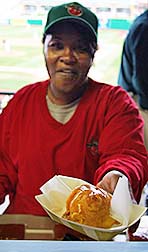 |
Sure, you’ll also find hot dogs, hamburgers, kids meals, Mexican and the like here, but one category that you typically don’t find at ballparks is healthy fare. The TinCaps might lead the league in this stat, as Parkview Health System, which purchased the naming rights for the ballpark, had great influence over what’s on the menu. Here you’ll find Caesar Salad wraps, vegetarian burgers, salads and grilled chicken.
There’s an attractive souvenir shop with reasonably priced items (most adult T-shirts are $18). Here you’ll find the team’s new, adorable logo on all kinds of souvenirs, but when I visited (which was during the park’s first week), I was dismayed to find that there were no lapel pins to be found. None that showed the park. None that showed the cute logo. When I asked where they were displayed, I was informed that not only didn’t they have any in stock, ordering them had never even been contemplated. Since that is my favorite souvenir items to collect, I was extremely disappointed.
Perhaps because of my complaint (but in reality, it probably had nothing to do with it), I’m told that lapel pins did find their rightful place on the shelves of the store after the first homestand. Good. Now I won’t have to form a picket line in front of the park’s gates.
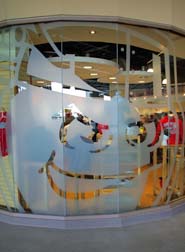 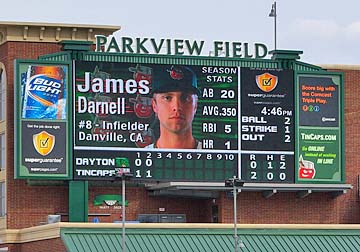 |
As you can see above, the team thinks enough of the logo to etch it massively in the front windows of the souvenir shop (but not enough to make pins of it to sell on opening day I guess). In fact, you’ll find the logo on display in many ways around the park. I know that Baseball America (the cost to subscribe to it, by the way, long since passed through the stratosphere) panned the logo when it was announced, but I think it has appeal to youngsters, and a lot of apparel and souvenirs are indeed purchased for the younger crowd. Therefore, the team might as well display it anywhere and everywhere.
The scoreboard is certainly one of the nicest in Single-A baseball (again, how did they include all of this for only $30 million?). It is a high-resolution video board measuring a healthy 53′ by 26′, and the team uses it for video skits, ads and, of course, lots of game information (above right).
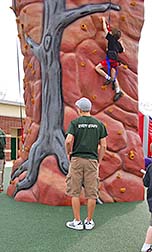 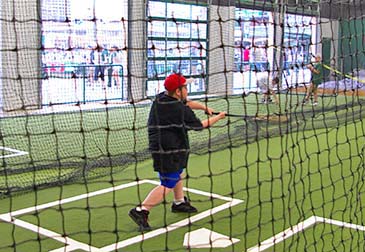 |
Kids are very, very well taken care of at Parkview Field. The play area near the left-field corner has quite a few inflatables plus something that is akin to a rock-climbing wall. This one, though, is shaped like an — of course — apple tree (above left). Not far away are the ground-level fountains that kids can run through and splash around in.
The best feature for youngsters — maybe slightly older youngsters — is the batting-cage area behind first base. Patterned after ones at the park in Stockton, these are the actual cages used by the players prior to games. As gametime nears, the players clear out and the public can go into the cages and take some swings against a pitching machine (above right). It’s well worth the $2 cost.
Summary
Jason Freier, who was a tremendous help in putting this review together, told me that he is “thrilled with the way the ballpark turned out.” He should be. He, and the fans of Fort Wayne, received a tremendous ballpark for their $30-million investment.
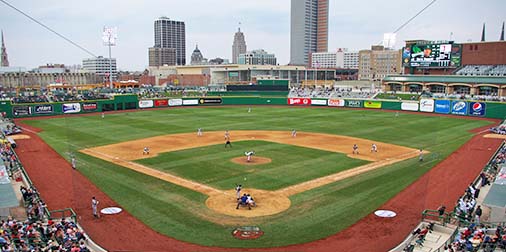 |
“We put a lot of thought into the ballpark, both from a pure aesthetic standpoint and also from the perspective of the quality and variety of experiences we would be able to provide inside the ballpark,” he added. Aside from the obvious misdeed of failing to order lapel pins for the first homestand, I would eagerly agree that Parkview Field works from both an aesthetic and a functional point of view. If John Chapman came back to life today and visited downtown Fort Wayne, he’d no doubt love this ballpark, even though he probably never saw a game of what we know as baseball.
But after watching a few innings, he’d no doubt pop his tin cap on his head and wander out to the outfield to plant some appleseeds.
Great site and great review. It would be awesome if there were some kind of “printer friendly” button that would set up the article and pictures for the best print copy to take along on a trip.
Great suggestion. Next time my programmer is working on things for the site, I’ll ask him about your suggestion.